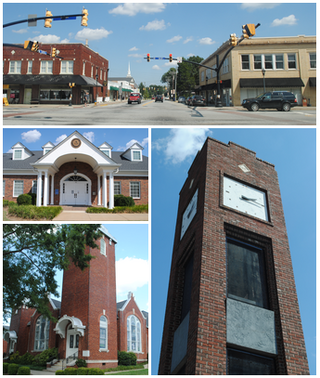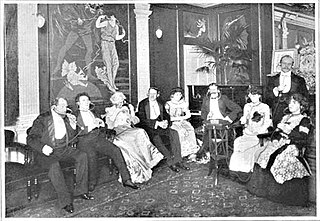
Cable television is a system of delivering television programming to consumers via radio frequency (RF) signals transmitted through coaxial cables, or in more recent systems, light pulses through fibre-optic cables. This contrasts with broadcast television, in which the television signal is transmitted over-the-air by radio waves and received by a television antenna attached to the television; or satellite television, in which the television signal is transmitted over-the-air by radio waves from a communications satellite orbiting the Earth, and received by a satellite dish antenna on the roof. FM radio programming, high-speed Internet, telephone services, and similar non-television services may also be provided through these cables. Analog television was standard in the 20th century, but since the 2000s, cable systems have been upgraded to digital cable operation.
The People's Republic of China possesses a diversified communications system that links all parts of the country by Internet, telephone, telegraph, radio, and television. The country is served by an extensive system of automatic telephone exchanges connected by modern networks of fiber-optic cable, coaxial cable, microwave radio relay, and a domestic satellite system; cellular telephone service is widely available, expanding rapidly, and includes roaming service to foreign countries. Fiber to the x infrastructure has been expanded rapidly in recent years.

A telephone is a telecommunications device that permits two or more users to conduct a conversation when they are too far apart to be easily heard directly. A telephone converts sound, typically and most efficiently the human voice, into electronic signals that are transmitted via cables and other communication channels to another telephone which reproduces the sound to the receiving user. The term is derived from Greek: τῆλε and φωνή, together meaning distant voice. A common short form of the term is phone, which came into use early in the telephone's history.

AM broadcasting is radio broadcasting using amplitude modulation (AM) transmissions. It was the first method developed for making audio radio transmissions, and is still used worldwide, primarily for medium wave transmissions, but also on the longwave and shortwave radio bands.

Mauldin is a city in Greenville County, South Carolina. The population was 24,724 at the 2020 census. It is a principal city of the Greenville-Anderson-Mauldin Metropolitan Statistical Area.

Simpsonville is a city in Greenville County, South Carolina. It is part of the Greenville-Mauldin-Easley Metropolitan Statistical Area. The population was 22,234 at the 2020 census, up from 18,238 in 2010. Simpsonville is part of the "Golden Strip", along with Mauldin and Fountain Inn, an area which is noted for having low unemployment due to a diversity of industries including H.B. Fuller, KEMET, Sealed Air and Milliken.

Ware Shoals is a town in Abbeville, Greenwood, and Laurens counties in the U.S. state of South Carolina, along the Saluda River. Ware Shoals has a population of 1,607 according to the 2020 United States Census.

Electric power distribution is the final stage in the delivery of electricity. Electricity is carried from the transmission system to individual consumers. Distribution substations connect to the transmission system and lower the transmission voltage to medium voltage ranging between 2 kV and 33 kV with the use of transformers. Primary distribution lines carry this medium voltage power to distribution transformers located near the customer's premises. Distribution transformers again lower the voltage to the utilization voltage used by lighting, industrial equipment and household appliances. Often several customers are supplied from one transformer through secondary distribution lines. Commercial and residential customers are connected to the secondary distribution lines through service drops. Customers demanding a much larger amount of power may be connected directly to the primary distribution level or the subtransmission level.

A telephone line or telephone circuit is a single-user circuit on a telephone communication system. It is designed to reproduce speech of a quality that is understandable. It is the physical wire or other signaling medium connecting the user's telephone apparatus to the telecommunications network, and usually also implies a single telephone number for billing purposes reserved for that user. Telephone lines are used to deliver landline telephone service and Digital subscriber line (DSL) phone cable service to the premises. Telephone overhead lines are connected to the public switched telephone network. The voltage at a subscriber's network interface is typically 48 V between the ring and tip wires, with tip near ground and ring at –48 V.
A landline is a telephone connection that uses metal wires or optical fiber telephone line for transmission, as distinguished from a mobile cellular network, which uses radio waves for signal transmission.
Carrier current transmission, originally called wired wireless, employs guided low-power radio-frequency signals, which are transmitted along electrical conductors. The transmissions are picked up by receivers that are either connected to the conductors, or a short distance from them. Carrier current transmission is used to send audio and telemetry to selected locations, and also for low-power broadcasting that covers a small geographical area, such as a college campus. The most common form of carrier current uses longwave or medium wave AM radio signals that are sent through existing electrical wiring, although other conductors can be used, such as telephone lines.

Electronic media are media that use electronics or electromechanical means for the audience to access the content. This is in contrast to static media, which today are most often created digitally, but do not require electronics to be accessed by the end user in the printed form. The primary electronic media sources familiar to the general public are video recordings, audio recordings, multimedia presentations, slide presentations, CD-ROM and online content. Most new media are in the form of digital media. However, electronic media may be in either analogue electronics data or digital electronic data format.

The Electrophone was a distributed audio system that operated in the United Kingdom, primarily in London, between 1895 and 1925. Using conventional telephone lines, it relayed live theatre performances, music hall shows, and Sunday church services to subscribers who listened over special headsets. It ultimately failed due to the rise of radio broadcasting in the early 1920s.
A party line is a local loop telephone circuit that is shared by multiple telephone service subscribers.

Telecommunications engineering is a subfield of electronics engineering which seeks to design and devise systems of communication at a distance. The work ranges from basic circuit design to strategic mass developments. A telecommunication engineer is responsible for designing and overseeing the installation of telecommunications equipment and facilities, such as complex electronic switching systems, and other plain old telephone service facilities, optical fiber cabling, IP networks, and microwave transmission systems. Telecommunications engineering also overlaps with broadcast engineering.

Telephone Newspapers, introduced in the 1890s, transmitted news and entertainment to subscribers over telephone lines. They were the first example of electronic broadcasting, although only a few were established, most commonly in European cities. These systems predated the development, in the 1920s, of radio broadcasting. They were eventually supplanted by radio stations, because radio signals could more easily cover much wider areas with higher quality audio, without incurring the costs of a telephone line infrastructure.
WROO is a sports radio station licensed to Mauldin, South Carolina, and serves the Upstate, including Greater Greenville and some of Spartanburg. The iHeartMedia, Inc. outlet is licensed by the U.S. Federal Communications Commission (FCC) to broadcast with an ERP of 2,300 watts. Its transmitter is located atop Paris Mountain in northern Greenville County, right above Greenville, where its studios are located downtown.

A telephone exchange, telephone switch, or central office is a telecommunications system used in the public switched telephone network (PSTN) or in large enterprises. It interconnects telephone subscriber lines or virtual circuits of digital systems to establish telephone calls between subscribers.
The United States Telephone Herald Company, founded in 1909, was the parent corporation for a number of associated "telephone newspaper" companies, located throughout the United States, that were organized to provide news and entertainment over telephone lines to subscribing homes and businesses. This was the most ambitious attempt made to develop a distributed audio service prior to the rise of radio broadcasting in the early 1920s.
The Musolaphone, developed by the Automatic Electric Company of Chicago, Illinois, was an audio distribution system that transmitted news and entertainment over telephone lines to subscribing homes and businesses. The company's "Automatic Enunciator" loudspeakers were employed at the receiving end.













